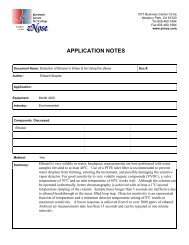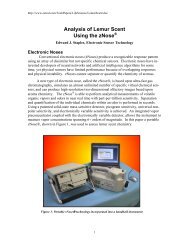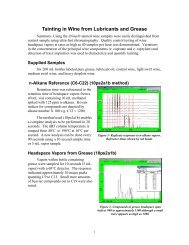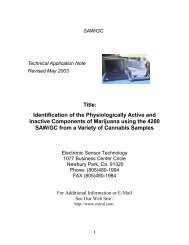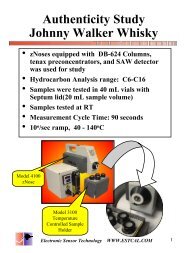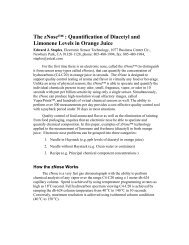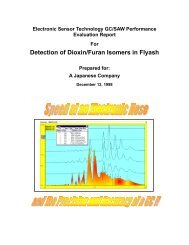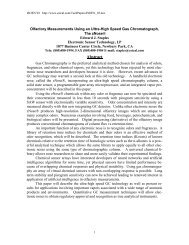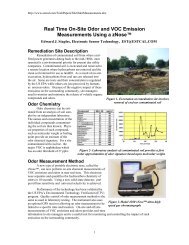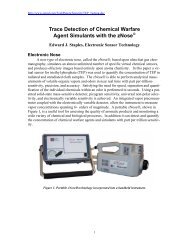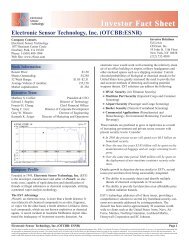A Portable SAW/GC Non-Intrusive Inspection System - Electronic ...
A Portable SAW/GC Non-Intrusive Inspection System - Electronic ...
A Portable SAW/GC Non-Intrusive Inspection System - Electronic ...
You also want an ePaper? Increase the reach of your titles
YUMPU automatically turns print PDFs into web optimized ePapers that Google loves.
A <strong>Portable</strong> <strong>SAW</strong>/<strong>GC</strong> <strong>Non</strong>-<strong>Intrusive</strong><br />
<strong>Inspection</strong> <strong>System</strong><br />
Edward J. Staples and Gary W. Watson<br />
<strong>Electronic</strong> Sensor Technology<br />
1077 Business Center Circle<br />
Newbury Park, Ca. 91320<br />
Tele: (805)480-1994, FAX (805)480-1984<br />
abstract<br />
<strong>Portable</strong> non-intrusive inspection systems to identify and quantify the presence of<br />
contraband at ports of entry, on personnel, within vehicles, and aboard cargo in ships and<br />
aircraft are needed. A low cost, easy to use, mobile trace analysis system which can be<br />
used to detect currency, explosives, firearms & munitions, hazardous chemicals, and<br />
general forensic screening is described in this paper.<br />
The portable inspection system to be described is part of a pilot program to<br />
develop a solid state vapor analysis system using surface acoustic wave (<strong>SAW</strong>) sensors<br />
and fast gas chromatography. <strong>SAW</strong>/<strong>GC</strong> technology needs no high voltages, utilizes<br />
essentially all solid state devices, and involves no radioactive or hazardous materials.<br />
<strong>SAW</strong>/<strong>GC</strong> systems have demonstrated dynamic ranges greater than 100,000 and the ability<br />
to detect vapors from contraband at the part per billion level.<br />
The fast <strong>SAW</strong>/<strong>GC</strong> inspection system identifies and quantifies vapor or particulate<br />
trace materials collected from ambient environments in near real time (< 10 seconds).<br />
The system is able to identify known vapor signatures and is equipped with a nonintrusive<br />
preconcentrator which does not require contact with the inspected object. The<br />
development of quantitative testing protocols and methods for drugs, currency, organophospate<br />
agents, and volatile organic compounds will be presented.<br />
Quantitative testing of the new <strong>SAW</strong>/<strong>GC</strong> technology has shown high selectivity,<br />
specificity, and 1-10 picogram sensitivity for drugs of abuse such as cocaine, marijuana,<br />
and heroin. Results achieved with prototype systems incorporating vapor/particulate<br />
detection using low voltage solid-state surface acoustic wave (<strong>SAW</strong>) vapor sensors, high<br />
speed (
Introduction<br />
This paper describes research on a fast<br />
portable non-intrusive inspection system to<br />
identify and quantify the presence of contraband<br />
at ports of entry, on personnel, within vehicles,<br />
and aboard cargo in ships and aircraft. The system<br />
utilizes fast <strong>GC</strong> vapor analysis with a new<br />
type of Surface Acoustic Wave (<strong>SAW</strong>) detector<br />
technology. The objective of this research project<br />
1 is to develop a low cost, easy to use, mobile<br />
trace analysis system which can be used to detect<br />
currency, explosives, firearms & munitions,<br />
and hazardous chemicals.<br />
<strong>System</strong> Description<br />
Prototype inspection systems 2 , as shown<br />
in Figure 1, are currently being used in field trials<br />
and data gathering experiments. The<br />
<strong>SAW</strong>/<strong>GC</strong> portion of the system is contained<br />
within a handheld module as shown. Support<br />
for the system (He carrier gas and electrical<br />
power) as well as a laptop computer and Windows®<br />
user interface is contained within a<br />
small suitcase.<br />
The <strong>SAW</strong>/<strong>GC</strong> system requires no high<br />
voltages, utilizes essentially all solid state de-<br />
1 This work was sponsored by the U.S. Army, <strong>Non</strong>-<br />
<strong>Intrusive</strong> <strong>Inspection</strong> Development, Evaluation, and<br />
Transition Management Structure, Contract No.<br />
DAAB10-95-C-0009.<br />
2 Partial support for early prototype inspection systems<br />
was provided by the Locheed Marrietta Corporation,<br />
Ocean <strong>System</strong> and Sensor Division, Syracuse, New<br />
York.<br />
.A <strong>Portable</strong> <strong>SAW</strong>/<strong>GC</strong> <strong>Non</strong>-<strong>Intrusive</strong><br />
<strong>Inspection</strong> <strong>System</strong><br />
Edward J. Staples and Gary W. Watson<br />
Amerasia Technology, Inc.<br />
2301 Townsgate Road<br />
Westlake Village, CA<br />
Tele: (805)495-9388, FAX (805)495-1550<br />
2<br />
.<br />
Figure 1- <strong>Portable</strong> <strong>SAW</strong>/<strong>GC</strong> <strong>Inspection</strong><br />
<strong>System</strong>.<br />
vices, and involves no radioactive or hazardous<br />
chemicals. The prototype <strong>SAW</strong>/<strong>GC</strong> system has<br />
demonstrated dynamic ranges greater than<br />
100,000 and the ability to detect and analyze<br />
vapors from contraband at the part per billion<br />
level (picograms/liter). The <strong>SAW</strong>/<strong>GC</strong> inspection<br />
system is fast and accurate. It identifies and<br />
quantifies vapor or particulate trace materials<br />
collected from ambient environments in near<br />
real time (< 10 seconds). Typically only 10 cc<br />
of ambient air needs to be collected with a 100<br />
ccm inlet flow prior to each analysis.<br />
Specificity and selectivity is based upon<br />
thermal management and material vapor pressure.<br />
The system is able to identify and alarm<br />
upon known vapor signatures and is non-intrusive<br />
because it does not require contact with the<br />
inspected object. At this time test methods and
protocols have been developed for quantitative<br />
testing of vapor from drugs, currency, organophospate<br />
agents, and volatile organic compounds.<br />
Technology Description<br />
The basic operation of the <strong>SAW</strong>/<strong>GC</strong> system<br />
is illustrated in Figure 2. The system utilizes<br />
a two position, 6 port <strong>GC</strong> valve to switch<br />
between sampling and injection ports. In the<br />
sample position environmental air is passed<br />
through an optional inlet preconcentrator and<br />
then through a sample loop trap.<br />
The preconcentrator provides the system<br />
with the ability to concentrate inlet with high<br />
flow. The function of the loop trap is to retain<br />
contraband aerosols materials when in the sample<br />
position. During sampling, helium carrier<br />
gas flows down a capillary column, through a<br />
nozzle, and onto the surface of a temperature<br />
controlled <strong>SAW</strong> resonator crystal 3 as shown in<br />
Figure 3.<br />
Switching the valve to the inject position<br />
causes helium carrier gas to flow backwards<br />
through the loop trap and onto the column. After<br />
the valve is switched into the inject position<br />
the loop trap is rapidly heated to 200 o Figure 2- <strong>SAW</strong>/<strong>GC</strong> <strong>System</strong> Description.<br />
C causing<br />
3 United States Patent No. 5,289,715, Vapor Detection<br />
Apparatus and Method Using an Acoustic<br />
Interferometer.<br />
3<br />
the trapped contraband materials to be released<br />
into the <strong>GC</strong> column. The temperature of the <strong>GC</strong><br />
column is linearly raised to 250 o C over a 5-10<br />
second time and this causes the contraband materials<br />
to travel down the column and exit at a<br />
time dependent upon the vapor pressure and<br />
column absorption of each vapor.<br />
The <strong>SAW</strong> resonator represents a new<br />
class of <strong>GC</strong> detector. Condensable vapors as<br />
they exit the <strong>GC</strong> column are focused and<br />
trapped on the surface of the resonator and cause<br />
a change in the characteristic frequency of the<br />
crystal resonator. The inherent frequency stability<br />
of the resonator, typically 1x10 -10 Figure 3- Surface Acoustic Wave <strong>GC</strong><br />
Detector.<br />
•Fo, results<br />
in femtogram sensitivity. The adsorption efficiency<br />
of each vapor is a function of the surface<br />
temperature and the material vapor pressure. By<br />
operating the crystal at different temperatures,<br />
detection can be made specific to vapors based<br />
upon their characteristic vapor pressure. Also,<br />
since the crystal acts as a micro-balance it integrates<br />
the total amount of condensed vapor and<br />
to obtain a familiar chromatogram plot of flux<br />
Vs retention time, the derivative of frequency<br />
Vs time is calculated. This is in contrast to the<br />
operation of a conventional <strong>GC</strong> detector which<br />
detects the flux and integral calculations are required<br />
to obtain the amount of each material<br />
present.<br />
Field Test Results
At the present time prototype <strong>SAW</strong>/<strong>GC</strong><br />
vapor analysis systems are being field tested<br />
under many different conditions. These tests<br />
include monitoring of VOC contamination of<br />
soil and groundwater at DOE SuperFund sites<br />
and as aids in training canines to detect drugs of<br />
abuse.<br />
In a recent field test, a prototype<br />
<strong>SAW</strong>/<strong>GC</strong> system participated in a Detection Assessment<br />
Program 4 sponsored by the U.S. Government.<br />
The instrument was first calibrated<br />
using a vapor generator. A typical scale factor<br />
for cocaine vapor was 17 Hz/pg. Large plywood<br />
boxes, 4 x 4 x 6 feet (2700 cu liters) as shown in<br />
Figure 4, were used to simulate cargo<br />
containers.<br />
In one test a 1 kg brick of cocaine was<br />
placed at the bottom of the container and al-<br />
<strong>SAW</strong>/<strong>GC</strong><br />
Sensor Head<br />
Upper<br />
Sampling<br />
Port<br />
Lower<br />
Sampling<br />
Port<br />
Figure 4- Plywood box with vinyl liner<br />
containing cocaine vapor source.<br />
lowed to equilibrate for 24 hours. Following a<br />
testing protocol, the room was sampled first and<br />
found to contain cocaine vapors but at a very<br />
low level. Next the container was tested. Ten<br />
second chromatograms of vapor samples taken<br />
at the top and bottom holes of the container are<br />
shown in Figure 5 and Figure 6. Sampling 10 cc<br />
of ambient air at the lower opening indicated<br />
cocaine vapors with a frequency shift of<br />
approximately 4000 Hz while at the top of the<br />
4 Cocaine and Heroin Vapor/Particle Detection <strong>System</strong><br />
Assessment Program, USCS93100, Rev. D (9-30-94).<br />
4<br />
Figure 5-Analysis of vapors taken at top of<br />
container.<br />
Cocaine Peak<br />
Amount Detected<br />
Figure 6- Analysis of vapors taken at bottom<br />
of container.<br />
container less than 100 Hz of frequency shift<br />
was observed. The results were quite repeatable<br />
and are consistent with vapor characteristics observed<br />
with other non-volatile materials. The<br />
detected frequency shifts are converted to<br />
cocaine vapor concentration in pg/liter factor in<br />
Figure 7.<br />
The actual measurements show a concentration<br />
less than 58 pg/liter at the top and a<br />
• 17 Hz/pg Scale Factor<br />
• Top:
This more than saturated cocaine vapor concentration<br />
of 1.442 ng/liter at 20 o C. Within the 10<br />
cc sample taken by the inspection system, approximately<br />
235 pg of cocaine was detected.<br />
It is interesting to note that the cocaine<br />
vapor concentration at the bottom of the container<br />
is considerably higher than saturated vapor<br />
at room temperature (1.44 ng/liter) and that<br />
a considerable gradient exists within the container<br />
even after waiting 24 hours before performing<br />
the test. It is speculated that the diffusion<br />
constants for non-volatile materials are so<br />
low that equilibration does not occur except<br />
over extremely large time periods.<br />
Recent chromatography improvements<br />
in the <strong>SAW</strong>/<strong>GC</strong> have shown it is possible to<br />
quickly detect cocaine vapor at the picogram per<br />
liter level using only a small sample of the<br />
ambient air. Cocaine specificity and selectivity<br />
for the inspection system has been optimized.<br />
Current systems are able to achieve 2000 plate<br />
cocaine peaks as shown in Figure 8. In this<br />
chromatogram a cocaine peak with an area of<br />
7386 Hz (434 pg) and a retention time of 7.1<br />
Figure 8-<strong>GC</strong> Method Optimized for cocaine<br />
detection.<br />
seconds is shown to heave a half width of only<br />
140 milliseconds. Because the <strong>SAW</strong> detector<br />
integrates the sample directly it has no dead<br />
volume and can readily detect picogram and<br />
even femtogram vapor concentrations.<br />
5<br />
Conclusions<br />
A new type of fast chromatography system,<br />
the <strong>SAW</strong>/<strong>GC</strong>, has been developed for analyzing<br />
vapors associated with volatile and nonvolatile<br />
materials. Tests have shown that vapor<br />
detection is a viable non-intrusive method of<br />
detection. <strong>Portable</strong> non-intrusive inspection systems<br />
to identify and quantify the presence of<br />
contraband are now being field tested.<br />
Current research goals are to reduce the<br />
size and cost while improving the performance<br />
of the inspection system. Future <strong>SAW</strong>/<strong>GC</strong> inspection<br />
systems will contain a sunlite readable<br />
user display as well as a high flow front end<br />
preconcentrator for sampling larger volumes of<br />
ambient air.<br />
A low cost, easy to use, mobile trace<br />
analysis system which can be used to detect currency,<br />
explosives, firearms & munitions, hazardous<br />
chemicals, and general forensic screening<br />
will benefit many government and commercial<br />
fields.<br />
Acknowledgments<br />
We wish to thank John Linnstaedt, our<br />
Contracting Officer, for his support and supervision.<br />
This work was sponsored by the U.S.<br />
Army, <strong>Non</strong>-<strong>Intrusive</strong> <strong>Inspection</strong> Development,<br />
Evaluation, and Transition Management Structure,<br />
Contract No. DAAB10-95-C-0009.<br />
Also we wish to express our appreciation<br />
to John Decker and Doug Low of the Lockheed-<br />
Martin Corporation for their participation in the<br />
U.S. Army’s Detection Assessment Program<br />
field test. Construction of MVS-200 prototype<br />
<strong>SAW</strong>/<strong>GC</strong> systems was funded by the Lockheed<br />
Martin Corporation.



